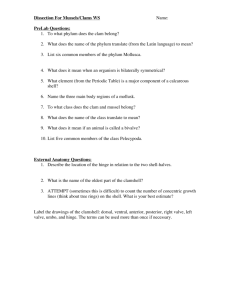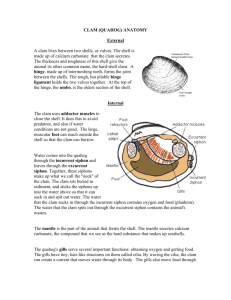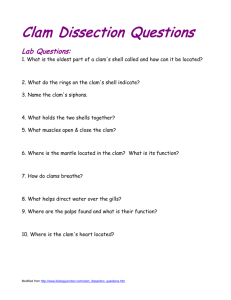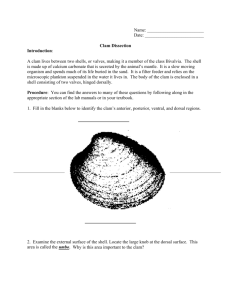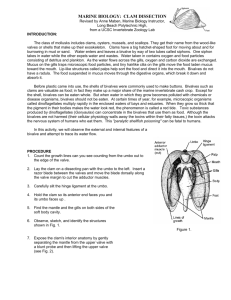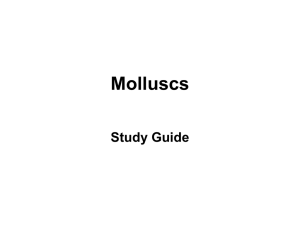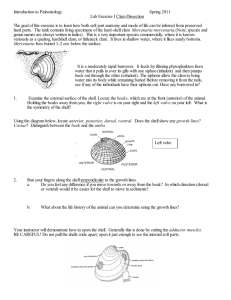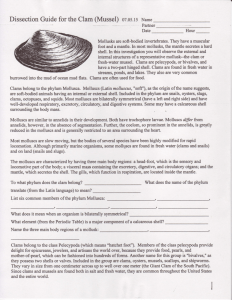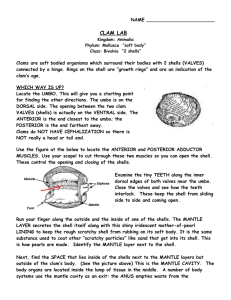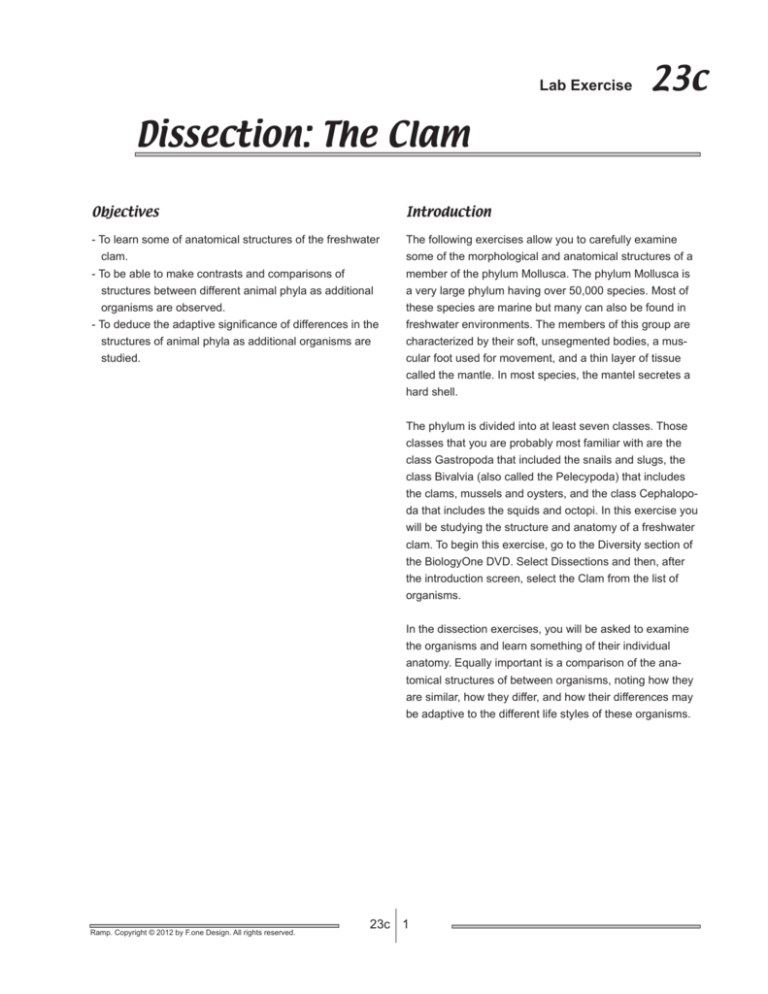
Lab Exercise
23c
Dissection: The Clam
Objectives
Introduction
- To learn some of anatomical structures of the freshwater
clam.
- To be able to make contrasts and comparisons of
structures between different animal phyla as additional
organisms are observed.
- To deduce the adaptive significance of differences in the
structures of animal phyla as additional organisms are
The following exercises allow you to carefully examine
some of the morphological and anatomical structures of a
member of the phylum Mollusca. The phylum Mollusca is
a very large phylum having over 50,000 species. Most of
these species are marine but many can also be found in
freshwater environments. The members of this group are
characterized by their soft, unsegmented bodies, a muscular foot used for movement, and a thin layer of tissue
called the mantle. In most species, the mantel secretes a
hard shell.
studied.
The phylum is divided into at least seven classes. Those
classes that you are probably most familiar with are the
class Gastropoda that included the snails and slugs, the
class Bivalvia (also called the Pelecypoda) that includes
the clams, mussels and oysters, and the class Cephalopoda that includes the squids and octopi. In this exercise you
will be studying the structure and anatomy of a freshwater
clam. To begin this exercise, go to the Diversity section of
the BiologyOne DVD. Select Dissections and then, after
the introduction screen, select the Clam from the list of
organisms.
In the dissection exercises, you will be asked to examine
the organisms and learn something of their individual
anatomy. Equally important is a comparison of the anatomical structures of between organisms, noting how they
are similar, how they differ, and how their differences may
be adaptive to the different life styles of these organisms.
Ramp. Copyright © 2012 by F.one Design. All rights reserved.
23c 1
Activity 23c.1
Body Morphology
Activity 23c.2
Internal Anatomy
Observe the exterior of the clam. The soft part of the
clam’s body is protected by a shell consisting of two valves
hinged along one side. Is its shell symmetrical from side
to side? From front to back? You should be able to find a
raised region anterior to the hinge. This is called the umbo
and is the oldest part of the shell. Along the posterior
edge of some shells you may be able to find two openings
between the valves. The opening farther from the hinge is
the incurrent siphon that allows water to flow to the inside
of the shell. The opening closer to the hinge is the excurrent siphon that allows the water to exit.
The body of the clam is composed of three main parts.
The thin layer of tissue that lines the inner wall of the shell
is the mantle. The second part of the body is the muscular
foot. The third part of the body is the visceral mass that
contains the organs. Cut away the mantle that covers the
body of the clam. Click on the forward arrow in the lower
right to remove the mantel. The structures that you can
see without opening the body are the gills that extend posteriorly from below the umbo and the labial palps that are
at the anterior end of the body. The labial palps surround
the mouth.
Become familiar with the external features of the clam.
The gills are one of the respiratory organs of the clam. Cilia on the gills and mantle create a current that draws water
through the incurrent siphon into the space surrounding
the gills. Water then exits through the excurrent siphon.
The gills serve a duel purpose in the clam. Not only do
they exchange respiratory gases with the water but they
also filter food particles from the water. These small food
particles are moved by cilia along grooves to the mouth.
To open the shell and observe the body of the clam you
must cut the adductor muscles that hold the two valves
closed. One is located in front of the hinge and the other
is located behind. To cut these muscles, insert a scalpel
between the valves. Holding the blade against the inner
wall of one of the valves, carefully work the blade through
the muscle. Keep the blade as close against the shell as
possible to avoid cutting the soft body of the muscle.
Repeat this process on the second adductor muscle. Click
on the forward arrow in the lower right to complete this
dissection.
The mantle of the clam is also highly vascularized and
serves as a second respiratory organ.
Most members of the phylum Mollusca have an open
circulatory system. This means that the blood, once
pumped by the heart, does not stay in blood vessels but
flows through large spaces in the body called sinuses. The
blood then is collected from these sinuses and returned to
the heart through veins.
You can view the heart of the clam by carefully cutting and
pulling back some of the mantel from just under the hinge.
You should see a space here, the pericardial sinus. Within
this space you should see the elongate heart of the clam.
With careful examination you may be able to see the pores
through which the blood is pumped out of the heart into
the body sinuses. To complete this dissection, click on the
forward arrow in the lower right.
Just below the pericardial sinus is nephridium that is
responsible for filtering wastes from the blood. To observe
the organs of the clam’s digestive system, use your scal-
Ramp. Copyright © 2012 by F.one Design. All rights reserved.
23c 2
pel to carefully bisect the foot and visceral mass into left
and right halves. Click on the forward arrow in the lower
right to complete this dissection.
Once dissected, you should be able to follow the digestive system from the mouth, along a short tube to the
stomach. The stomach sorts out the non-digestible material and receives enzymes to breakdown the digestible
material. The enzymes are produced by the digestive
gland which is the soft gray-green tissue surrounding the
stomach and intestine. Undigested food passes from the
stomach, through the intestine and out through the anus.
The waste material is then flushed from the mantle cavity
by the water flowing through the excurrent siphon.
Depending on the season during which the clam was collected, you may see a large or small mass of soft yellowish tissue. This is the gonad that produces sperm or eggs.
After studying the internal features of the clam, label the
illustration located in the Results Section.
Ramp. Copyright © 2012 by F.one Design. All rights reserved.
23c 3
Ramp. Copyright © 2012 by F.one Design. All rights reserved.
23c 4
8. _____________________
7. _____________________
incurrent
siphon
excurrent
siphon
6. _____________________
5. _____________________
23c
4. _____________________
labial
palp
3. _____________________
2. _____________________
1. _____________________
stomach
Lab Exercise
Name _______________________
Results Section
Activity 23c.2
Internal Anatomy
Label the illustration below

